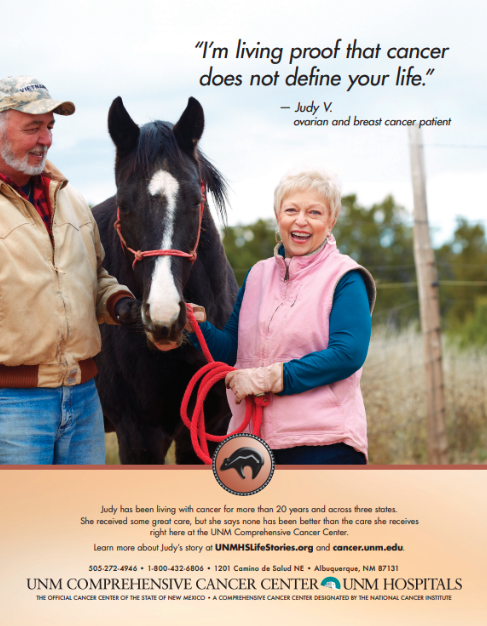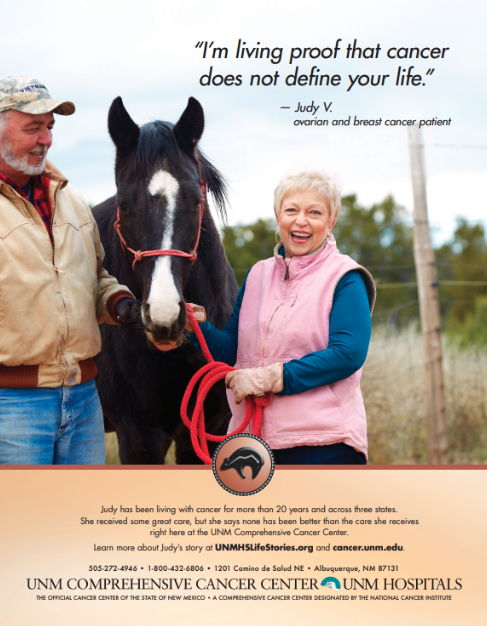Case study: University of New Mexico Health System

Humanizing a Health System
Beyond their mission to deliver high-quality care and optimal patient outcomes, hospitals and health systems today face a common and urgent challenge: financial sustainability. Escalating costs, workforce shortages, increasing administrative hurdles, and uncertain reimbursement are straining their ability to operate effectively.
Our work with the University of New Mexico Health System shows how strategic, patient-centered communications can help address these pressures. By humanizing their health system’s brand and positioning the institution as both a provider of high-quality care and a vital community resource, we helped build trust and support long-term financial resilience.

The challenge
Hospitals and health systems face a perfect storm of perceptual, financial, and operational pressures.
- Consumers are increasingly frustrated with all aspects of health care, including the cost of insurance, access to services, the quality of health care delivery, and controversial public health issues — all of which has a negative impact on the general perception of health care institutions.
- Staffing shortages, including a dearth of physicians in many locales, have strained capacity, impacted care quality, and driven up labor costs.
- Medicare and Medicaid, responsible for more than 60% of hospital revenue nationwide, is failing to keep pace with rising costs. Recent federal legislation will further impact reimbursement and potentially lead to more individuals without health coverage.
- A shifting policy landscape, including price transparency mandates and new rules for prior authorizations, is adding administrative burden without necessarily improving patient health outcomes.
Amid all this, hospitals and health systems are increasingly called upon to address broader public health needs, such as mental health and addiction, often without the funding or infrastructure to support this expanded role.
Our insights
While branding and marketing communications alone can’t solve every challenge facing hospitals and health systems, they are powerful tools for navigating today’s most pressing threats. When patients, clinicians and staff, elected officials, and regulators believe in a hospital’s mission and trust its reputation for care, they are more likely to support it.
Further, as this case study demonstrates, strategic branding can counter negative public perceptions and reshape narratives in ways that directly support financial sustainability, workforce recruitment, and political leverage.
- In a tight labor market, being seen as a great employer helps attract and retain nurses, physicians, allied health care professionals, and staff.
- Hospitals that are perceived as essential to their communities, providing a high-touch and high-quality care experience, engender public trust and political capital. This is particularly true in rural areas where a hospital may be the sole provider.
- Foundations, donors, and partners are more likely to invest in institutions with a clear identity, compelling story, and demonstrated impact.
- The University of New Mexico Health System (UNM) stood at a pivotal moment. A critical tax referendum, essential to unlocking millions in public funding, was projected to fail. Public perception was a problem. Many viewed UNM as a safety-net hospital, serving only low-income patients and lacking the high-quality care found at nationally ranked institutions.

As always, our strategy was research based. We found the institution was spending too much time talking about itself — its doctors and equipment. Patients wanted to feel confident they’d have an attentive provider relationship that led to a good outcome.
Phil Loscoe
Managing Partner at RDW and lead on the account
Our approach: A patient-centered pivot
UNM’s previous advertising, focused on physicians and advanced technology, wasn’t moving the needle. Our research uncovered a deeper truth: While patients demand clinical excellence, they also want and value reassurance, connection, and outcomes.
Accordingly, we developed a fully integrated campaign grounded in UNM’s unique culture and the lived experiences of its patients. Through powerful, authentic stories — told by actual patients — we spotlighted the care only UNM could provide. These narratives, woven together with the voices of UNM clinicians, humanized the institution and built emotional trust, shifting long-held misperceptions.

To reinforce the brand campaign, we launched targeted service line marketing to educate the public about available care. These mini-campaigns focused on pediatrics, women’s health, neurology, and cancer care — the services patients and their families told us mattered most. They provided clear, compelling proof points that supported our overarching message of excellence in patient-centered care Creative projects in support of our efforts included.
62%
of voters approved the tax referendum, a 40-point swing
#1
ranked for NM cancer care, up from #3 at campaign start
The results

The campaign improved public perceptions of UNM tremendously, UNM’s standing in the community was strengthened measurably:
Campaign success also helped UNM exceed fundraising goals and supported physician recruitment.
62% (a 40-point swing from earlier polling) of New Mexico voters approved the tax referendum, securing critical public funding for the future.
Research showed that UNM ranked #1 in New Mexico for cancer care, up from #3 at campaign launch. The UNM Cancer Center earned Comprehensive NCI Designation, one of just 57 in the nation.
The bottom line
In today’s environment, where hospitals and health systems must fight for resources, staff, and public trust, branding is more than a marketing tool… it’s a strategic asset. UNM’s story shows how emotionally resonant, patient-centered branding can reshape public perception and deliver measurable results: securing funding, attracting patients, recruiting talent, and reinforcing a hospital’s value to its community.
